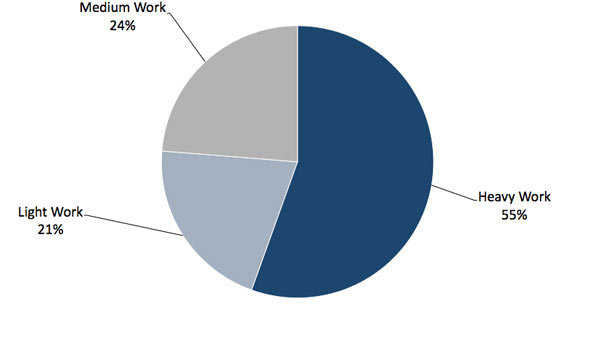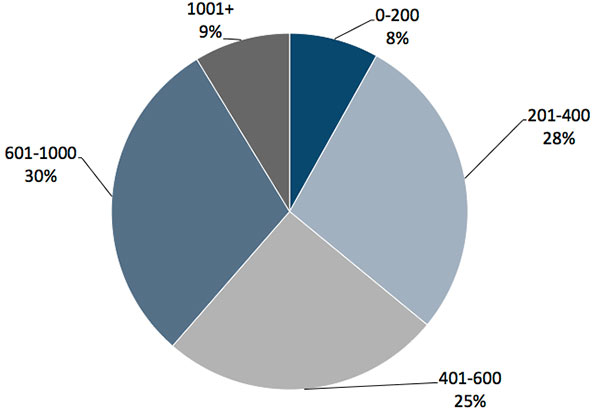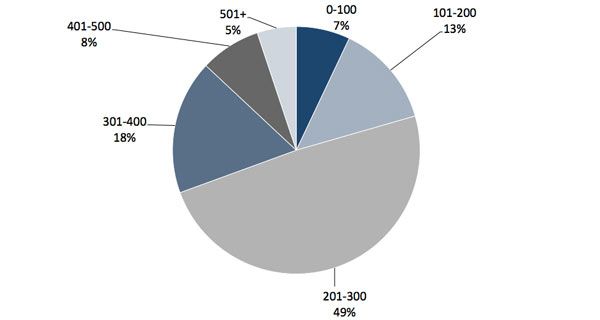ROVing further every year
Kieran O’Brien, Infield Systems, UK, examines the growing importance of ROVs within the offshore oil and gas industry.
Work class ROVs are indispensable in the offshore oil and gas industry, working on a whole spectrum of life-of-field applications from exploration drill support to decommissioning of offshore infrastructure. There are over 1100 work class ROVs servicing the global market at present. Infield Systems’ ROV database (InfieldROV) divides these work class ROVs into three categories – light work, medium work and heavy work. These categories are defined by the horsepower of a unit; the split can be seen in Figure 1.

Figure 1. Work class ROVs by unit type. Source: Infield Systems’ InfieldROV database.
Heavy work vehicles (those vehicles with more than 150 HP) make up 55% of the supply of work class ROVs, with light work (those between 10 HP and 100 HP) and medium work vehicles (those between 101 HP and 149 HP) making up 22% and 23% of supply respectively.
In order to provide the most complete assessment of the supply and demand potential of the global ROV market, Infield Systems continually updates its ROV market database (InfieldROV) and then applies a complex model to the data, which takes multiple factors into consideration in order to provide long-term market forecasts.
Both ROV operators and manufacturers are highly polarised. Work class ROVs from the top five manufacturers make up 80% of the global fleet whilst the smallest 15 manufacturers by the number of work class ROVs active, have manufactured just under 5% of the global fleet. Operators meanwhile see slightly lower levels of polarisation with 52% of work class ROVs owned and operated by the top five companies by fleet numbers.
Oceaneering is the largest company in terms of both manufacturing and operating ROVs, primarily because it operates the work class ROVs it manufactures, selling very few. Closely following Oceaneering in the manufacturing sector is Perry Slingsby Systems, owned by Forum Energy Technology, with dozens of smaller operators owning Perry machines. SMD and FMC Schilling Robotics are the next largest manufacturers, both having established long lasting relationships with key clients to whom they provide a large proportion of their systems. The small proportion of manufacturing market share held by smaller companies is due to the high barriers of entry to the market. As a result of the high level of standardisation within the ROV market, these smaller companies tend to instead focus on highly specialised vehicles, such as all-electric designs.

Figure 2. Work class ROV market share by manufacturer. Source: Infield Systems’ InfieldROV Database.
As mentioned above, Oceaneering is the largest operator of work class ROVs by number of systems. Oceaneering has more than double the number of systems than their nearest competitor, Subsea 7, which in turn has more than double the units of the next largest operator, Saipem. There are many comparatively small ROV operators, as companies use the relatively low cost of work class ROVs to augment their construction or inspection offering to the market. Any company with a dive support vessel or similar can use an ROV to perform many of the same functions as divers, but with the benefit of lower operational costs.
Work class ROVs are now used over the entirety of an oilfield’s life, from exploratory drilling to decommissioning.
In drilling, work class ROVs are utilised on almost all drilling platforms for observation, drill cuttings management and changing out BOP stacks. During development drilling, hook-up of wells becomes a major part of a work class ROV’s role.
Drilling activity forms a major proportion of ROV demand; work class ROVs will tend to be stationed aboard a drilling rig for their whole life. All semisubmersible rigs and drillships alongside a large proportion of jack-up rigs require an ROV to carry out any drilling. As a result, this will always remain a strong market for ROV operators and manufacturers. Moves towards deeper waters or harsher environments – both of which are anticipated as shallow water finds become more difficult – will only serve to enhance the requirements placed on work class ROVs for drilling.

Figure 3. Work class ROV market share by operator. Source: Infield Systems’ InfieldROV database.
Work class ROVs are utilised in the construction phase of a field’s life for observation and support for the entirety of the subsea construction process. Whether the platform is floating or fixed, work class ROVs are used for everything from installation of the jacket, hookup of the wells and installation of pipeline end manifolds. After installation, work class ROVs then assist in the life-of-field activities in the field, performing inspection, repair and maintenance activities – inspecting platforms, replacing sacrificial anodes and aiding in well interventions.
Decommissioning activities by work class ROVs range from decoupling control lines and cutting jackets for removal to inspecting pipelines, ensuring they are safe for burial and abandonment. Decommissioning is likely to be a major driver of ROV activity over the forecast period. The Gulf of Mexico, Southeast Asia and the North Sea are all major growth areas as they mature further and require greater spending on decommissioning. Much of the infrastructure in these areas has been utilised well beyond its original design life as high oil prices make maintenance and repair economically viable. As repair of old infrastructure becomes uneconomic, decommissioning activity will ramp up further. Decommissioning work tends to be complex and each solution needs to be tailored to the project based on a myriad of factors. There are many subsea trees that were installed before ROVs were commonplace and the valves on these trees tend to be only suitable for divers to operate. One innovation that would greatly aid the offshore industry would be a manipulator dextrous enough to handle these valves, removing the need for divers on potentially risky decommissioning work.
Figure 4 is produced from Infield Systems’ Specialist Vessels database and shows the changing requirements in the offshore oil and gas industry, where the forecast to 2019 has shallow water, 0 - 99 m and 100 - 499 m, declining as a proportion of overall vessel demand. Rising demand in deepwater and ultra-deepwater areas, such as Brazil, deepwater Gulf of Mexico and West Africa, is the main driver of this change. ROV operators are set to benefit from this changing market as divers cannot service any demand deeper than 300 m. The vast majority of the global ROV fleet is capable of operating at up to 3000 m, capable of serving almost the entirety of the global oil and gas industry.

Figure 4. Vessel demand (%) by water depth (m). Source: Infield Systems’ Vessels Database and Specialist Vessel Report.
The evolution of work class ROVs has resulted in a largely standardised design, with almost all work class ROVs capable of servicing almost all wells, regardless of depth. Due to the relatively low cost of these ROVs it is also vital that associated maintenance and downtime is kept to a minimum in order to avoid holding up a project many times more expensive than the ROV. This explains the continuing trend of modularisation in ROV manufacture, decreasing downtime for ROVs. Due to this standardisation, ROV manufacturers require different methods of differentiating their products.
All-electric work class ROVs may become more common as operations in the Arctic, where hydraulic leaks will not be tolerated, increase. Currently most manipulators require hydraulics as the torque driver from electric systems is insufficient for most applications.

Figure 5. Work class ROVs by excursion length (m) from tether management systems. Source: Infield Systems’ InfieldROV database.
Almost all new work class ROVs are capable of activities at 3000 m or more, placing almost all offshore oil and gas activity within their reach. A key means of product differentiation in the ROV market is not in the ROV itself, but in the excursion length possible from the tether management system (TMS). The most capable units can facilitate excursions up to 1600 m from the TMS, however, the majority of TMSs are capable of holding a tether long enough to grant less than 600 m of excursion. The most capable 9% are able to deploy over 1001 m of tether for operations. Higher excursion length means the ROV may be able to service an entire field without needing to be relocated, decreasing costs as the ROV does not need to be recovered to be moved.
The payload of an ROV (the amount it can carry) is generally a function of the amount of buoyancy added to a system. Figure 6 displays once again how Work Class ROVs tend to be standardised with the bulk of ROV systems capable of supporting 201 - 300 kg of payload. Light work vehicles tend to be those in the lower end of this category. Heavy work vehicles are typically larger, able to support more buoyancy and therefore able to carry heavier loads.

Figure 6. Work class ROVs by payload (kg). Source: Infield Systems’ InfieldROV database.
Historically, work class ROVs have had a limit on how old they can be to remain competitive, with ten years being the approximate lifespan of an ROV. As the standardisation and modularity of work class ROVs has increased this has become less important – it is less expensive to replace a manipulator than an ROV. Despite this, systems can become obsolete as better hardware and software becomes available. Oceaneering anticipates 4 - 5% fleet attrition1 over the next few years, a possible indication of the expected replacement rate necessary over the forecast. Manufacturing capacity, estimated to be above 150 Work Class ROVs per year, is more than capable of meeting an attrition rate of 5% across the global fleet with significant room for expansion of the ROV fleet.
Work class ROVs are ubiquitous in the offshore oil and gas industry; indeed, many of the inspection duties performed by ROVs can increasingly be performed by autonomous underwater vehicles (AUVs) – ROVs without the need for human intervention.
AUVs can be utilised to eliminate the need for an ROV pilot for jobs that are relatively simple, such as inspection activity, which means that large amounts of ROV demand can be met by automated, untethered systems. More demanding work such as construction will, for the foreseeable future, be met by piloted ROVs, but the automation of inspection activities presents a potentially significant cost saving to field operators.
ROVs are indispensable to the offshore oil and gas industry. Without work class ROVs, drilling would be confined to those water depths in which divers can operate, placing huge swathes of the ocean out of reach. ROVs provide a cost-effective solution necessary for tapping fields at greater water depths.
References
1. Oceaneering Annual Report 2012.
Read the article online at: https://www.oilfieldtechnology.com/exploration/21032014/roving_further_every_year/
You might also like
Rhino Resources and Halliburton to sign contract for integrated deep-water services offshore Namibia
Halliburton Company has announced it has been awarded a deep water integrated multi-well construction contract by Rhino Resources, a private company engaged in both onshore and offshore energy exploration in Africa.

